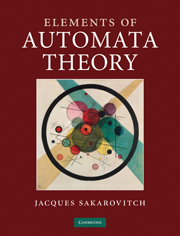Preface
Published online by Cambridge University Press: 05 September 2013
Summary
He who kisses many keeps few.
Popular adage
One cannot woo all women, but one should try.
Another adage
For a long time I would go through, head whirling, the writing of this preface. I would rattle off. whole sentences to give myself the heart to work. Now that I have to do it for real, I understand that the task is no easier than the heart of the work. How to justify writing a book on automata theory? Another one! and so thick! Justify? One can always dream; present, perhaps.
A shining light of computer science research in the nineteen-sixties, a compulsory part of instruction in the discipline in the seventies and eighties, automata theory seems to have disappeared from lecture theatre and conference hall. Nonetheless, we find it, explicitly or implicitly, in the essence or the premises of a number of subjects in computer science which are currently new or fashionable. As a possible explanation, I suggest that automata theory is the linear algebra of computer science. I mean this in two ways. Properly speaking, automata theory is non-commutative linear algebra, or can be viewed as such: the theory of matrices with coefficients in suitable algebras. I am more interested, however, in the figurative sense: automata theory as a basic, fundamental subject, known and used by everyone, which has formed part of the intellectual landscape for so long that it is no longer noticed. And yet, there it is, structuring it, organising it: and knowing it allows us to orient ourselves.
- Type
- Chapter
- Information
- Elements of Automata Theory , pp. xvii - xxivPublisher: Cambridge University PressPrint publication year: 2009

